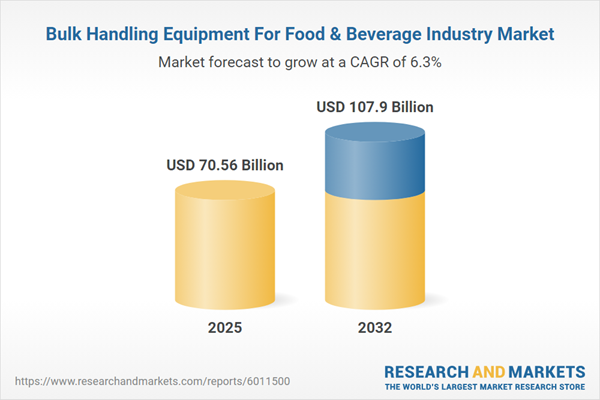Speak directly to the analyst to clarify any post sales queries you may have.
The bulk handling equipment market in the food and beverage industry is experiencing robust transformation, shaped by evolving safety standards, automation, and changing consumer demands. Senior leaders require actionable insights to navigate increasing complexity, enhance operational efficiency, and secure compliance in diverse manufacturing landscapes.
Market Snapshot: Bulk Handling Equipment for Food & Beverage Industry
The Bulk Handling Equipment for Food & Beverage Industry Market reached USD 66.39 billion in 2024 and is projected to grow to USD 70.56 billion by 2025, expanding at a CAGR of 6.25% to attain USD 107.90 billion by 2032. This market reflects rising investments in advanced handling solutions, a strong regulatory environment, and increased demand for modular, hygienic, and automated systems.
Scope & Segmentation
- Equipment Types: Bucket elevators, belt conveyors (including flat belt and modular belt configurations), chain conveyors, roller conveyors, rotary valve feeders, screw feeders, vibratory feeders, hoppers & storage bins, screw conveyors.
- System Types: Mechanical handling and pneumatic handling systems (covering pressure conveying including dense phase and dilute phase, and vacuum conveying solutions).
- Material Forms: Flakes, granular products, pellets, and powders.
- Operational Applications: Blending & mixing, feeding, loading & unloading, storage, and transfer processes.
- Automation Levels: Automatic, manual, and semi-automatic system architectures.
- Regional Coverage: Americas (United States, Canada, Mexico, Brazil, Argentina, Chile, Colombia, Peru), Europe, Middle East & Africa (U.K., Germany, France, Russia, Italy, Spain, Netherlands, Sweden, Poland, Switzerland, United Arab Emirates, Saudi Arabia, Qatar, Turkey, Israel, South Africa, Nigeria, Egypt, Kenya), and Asia-Pacific (China, India, Japan, Australia, South Korea, Indonesia, Thailand, Malaysia, Singapore, Taiwan).
- Key Companies Analyzed: GEA Group Aktiengesellschaft, Bühler AG, FLSmidth & Co. A/S, SPX Flow, Inc., Coperion GmbH, BEUMER Group GmbH & Co. KG, Hosokawa Micron Corporation, Cimbria A/S, Key Technology, Inc., John Bean Technologies Corporation.
Key Takeaways for Decision-Makers
- Operational efficiency and compliance are increasingly dependent on modular, automated equipment that meets hygiene and traceability standards.
- Digital transformation, involving real-time data acquisition and predictive maintenance, is reshaping plant operations and empowering proactive asset management.
- Manufacturers prioritize flexible system configurations to accommodate specialty products and frequent changeovers, responding to consumer demand for differentiated goods and enhanced food safety.
- Investment in energy-efficient drives, advanced control algorithms, and environmentally conscious materials supports both sustainability goals and cost reduction initiatives.
- Strategic supplier partnerships are crucial to expedite lead times and customize system designs in the context of global and regional shifts.
- Regulatory changes are driving rapid adoption of quick-clean and digitally traceable platforms, building consumer trust and lowering risk of costly recalls.
Tariff Impact on Procurement and Cost Structures
In 2025, the United States imposed additional tariffs on machinery imports, influencing procurement planning, budgeting, and total cost of ownership for bulk handling equipment. Companies are responding by localizing supply chains, diversifying sourcing strategies, and engaging in nearshoring or assembly partnerships to maintain flexibility and mitigate direct tariff effects.
Methodology & Data Sources
This report utilizes a mixed-methods approach, drawing from public literature, regulatory filings, industry databases, and proprietary machinery registries. In-depth interviews with engineers, procurement executives, and plant managers were supplemented with facility visits and vendor surveys for firsthand market validation. Rigorous analytical models, including PESTLE and SWOT frameworks, underpin scenario planning and trend analysis.
Why This Report Matters
- Supports informed capital allocation by aligning investments with specific process needs and strategic priorities.
- Equips leadership teams with a layered understanding of regional, technological, and regulatory dynamics influencing system adoption.
- Guides risk mitigation and procurement optimization in response to evolving market and trade policies.
Conclusion
This market analysis equips senior stakeholders with the critical knowledge to drive operational resilience, optimize asset lifecycle, and chart sustainable growth paths in the evolving bulk handling equipment sector for the food and beverage industry.
Additional Product Information:
- Purchase of this report includes 1 year online access with quarterly updates.
- This report can be updated on request. Please contact our Customer Experience team using the Ask a Question widget on our website.
Table of Contents
3. Executive Summary
4. Market Overview
7. Cumulative Impact of Artificial Intelligence 2025
Companies Mentioned
The companies profiled in this Bulk Handling Equipment For Food & Beverage Industry market report include:- GEA Group Aktiengesellschaft
- Bühler AG
- FLSmidth & Co. A/S
- SPX Flow, Inc.
- Coperion GmbH
- BEUMER Group GmbH & Co. KG
- Hosokawa Micron Corporation
- Cimbria A/S
- Key Technology, Inc.
- John Bean Technologies Corporation
Table Information
| Report Attribute | Details |
|---|---|
| No. of Pages | 197 |
| Published | October 2025 |
| Forecast Period | 2025 - 2032 |
| Estimated Market Value ( USD | $ 70.56 Billion |
| Forecasted Market Value ( USD | $ 107.9 Billion |
| Compound Annual Growth Rate | 6.2% |
| Regions Covered | Global |
| No. of Companies Mentioned | 10 |









